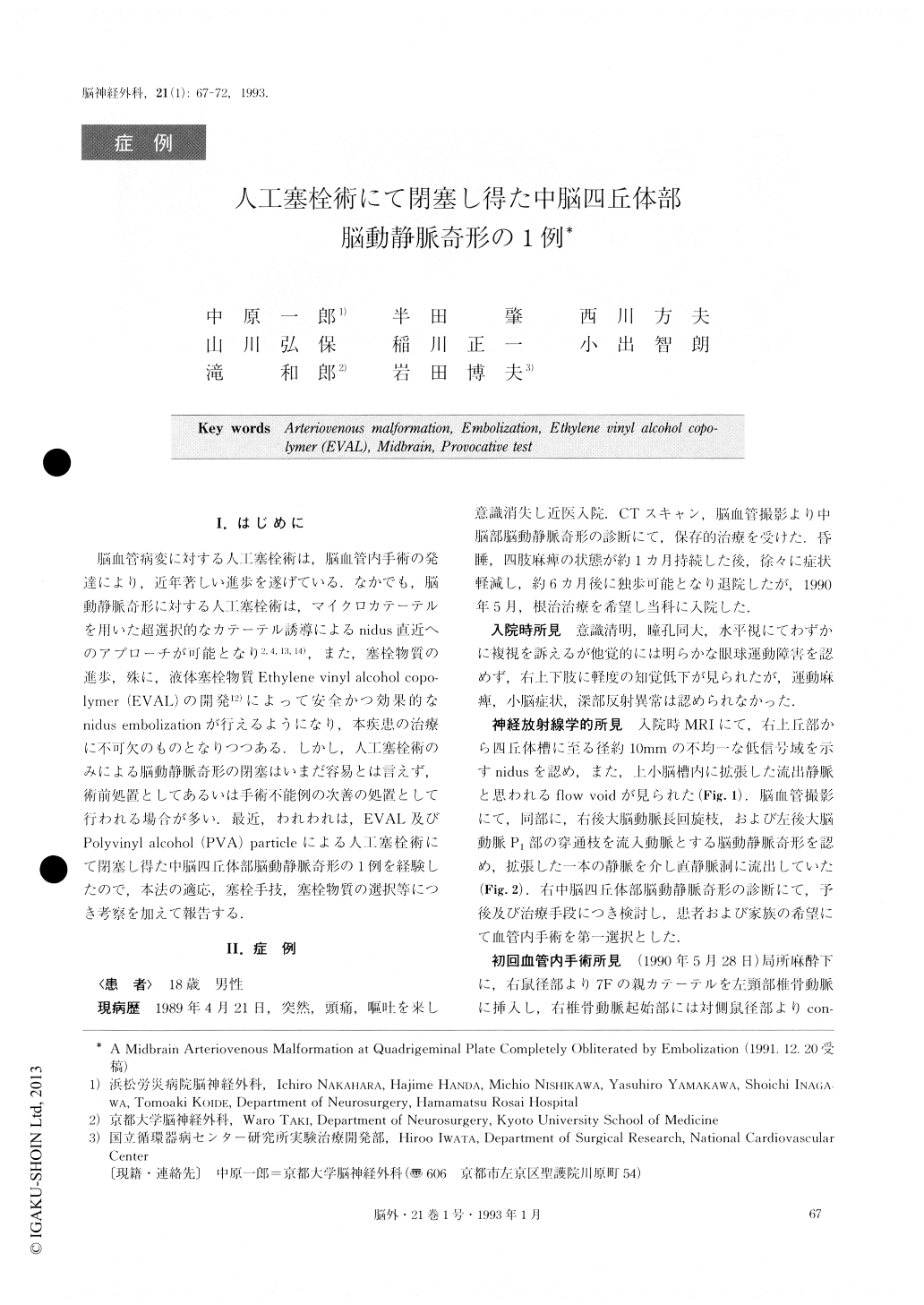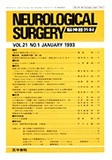Japanese
English
- 有料閲覧
- Abstract 文献概要
- 1ページ目 Look Inside
I.はじめに
脳血管病変に対する人工塞栓術は,脳血管内手術の発達により,近年著しい進歩を遂げている.なかでも,脳動静脈奇形に対する人工塞栓術は,マイクロカテーテルを用いた超選択的なカテーテル誘導によるnidus直近へのアプローチが可能となり2,4,13,14),また,塞栓物質の進歩,殊に,液体塞栓物質Ethylene vinyl alcohol copo—lymer(EVAL)の開発12)によって安全かつ効果的なnidus embolizationが行えるようになり,本疾患の治療に不可欠のものとなりつつある.しかし,人工塞栓術のみによる脳動静脈奇形の閉塞はいまだ容易とは言えず,術前処置としてあるいは手術不能例の次善の処置として行われる場合が多い.最近,われわれは,EVAL及びPolyvinyl alcohol(PVA)particleによる人工塞栓術にて閉塞し得た中脳四丘体部脳動静脈奇形の1例を経験したので,本法の適応,塞栓手技,塞栓物質の選択等につき考察を加えて報告する.
An eighteen year-old boy presented sudden loss of consciousness and tetraparesis. Radiological examina-tions revealed a ruptured midbrain arteriovenous mal-formation (AVM) at the right quadrigeminal plate. The patient recovered from symptoms by conservative treat-ment over 6 months with residual right hemisensory disturbance and mild diplopia during bilateral horizon-tal gaze. One year later, he was admitted to our insti-tute for radical treatment of the AVM. On the angiography, the AVM was fed by two branches of the right long circumferential artery and a left paramedian penetrating artery of the posterior cerebral artery (PCA), and drained into the straight sinus via a dilated quadrigeminal vein. After much discussion on several strategies, endovascular surgery was chosen as a radic-al treatment. In the initial session, a medial branch of the right long circumferential artery was catheterized with Tracker-18, and embolized with 1.0ml of ethylene vinyl alcohol copolymer (EVAL) without any deficits after negative provocative tests using Amytal and Xylo-caine. Then, a lateral branch of the same artery was embolized with 0.8ml of EVAL in the same way with-out any deficits. In the second session, catheterization into the left paramedian artery was difficult because of its small diameter and steep branching angle, and only a 3mm hooked tip of Tracker-18 could be canulated into the feeding pedicle. Left oculomotor palsy was in-duced by provocative Xylocaine test. However, angio-graphic cure of the AVM was expected to be made possible by the occlusion of this pedicle, and the proce-dure was continued due to the request of the patient and his family. For fear of reflux of liquid material into PCA, polyvinyl alcohol (PVA) particles measuring 150 -250μ were injected little by little, and the pedicle was obliterated by a cast of PVA particles with complete exclusion of the AVM from cerebral circulation. Post-embolization follow-up angiography performed 9 days later showed persistent complete obliteration of the AVM. The patient went back to a local hospital for further treatment for the left oculomotor palsy. Recent development of microcatheters and guide-wires enables us to get into small perforators in the brainstem. Provocative Xylocaine test appears very use-ful in predicting postembolization neurological deficits, particularly in the brainstem, because of its effect on axon as well as neuron. EVAL, a recently developed unique liquid embolic material, is extremely easy to handle and can be added through the same catheter re-peatedly. It is considered very useful for embolization of perforators in brainstem in which recanulation is dif-ficult. Treatment of brainstem AVMs is still challeng-ing even with modern microsurgery. Based on recent progress in this field, endovascular surgery could be an alternative for radical treatment in certain cases of these AVMs.

Copyright © 1993, Igaku-Shoin Ltd. All rights reserved.


